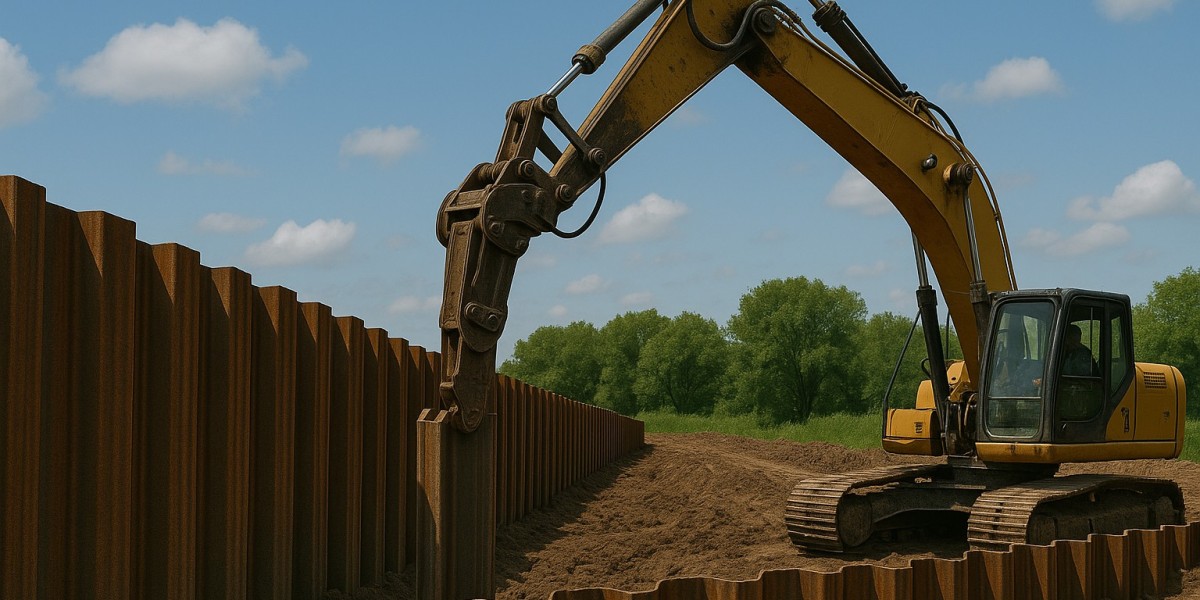Steel sheet piling provides robust support and is widely used in marine works, urban excavation, and infrastructure development. Knowing how it works and what affects installation costs will help you plan efficiently and select the right contractor.
What Is Steel Sheet Pile Installation
Steel sheet piles are long interlocking sections driven vertically into the ground to create a strong, continuous barrier. They are used to retain soil, control water flow, and stabilize excavation areas.
The process involves driving these sheets into place using vibratory hammers, hydraulic press systems, or impact hammers. Once installed, they form a durable wall that can handle lateral soil pressure and water loads effectively. Because of their strength and reusability, steel sheet piles are a preferred solution in many demanding projects.
Why Steel Sheet Piling Is a Preferred Choice
Steel sheet piles are known for their high load-bearing capacity and versatility. They can be used in a variety of soil conditions and are available in different profiles and lengths to match project needs.
Steel also offers durability and can be extracted and reused in future projects, making it a cost-effective option over time. For areas with high groundwater levels, heavy infrastructure loads, or difficult soil conditions, steel sheet piles provide performance and reliability that other materials cannot match.
Key Factors That Influence Steel Sheet Pile Installation
Soil Conditions and Geotechnical Factors
Challenging ground conditions such as dense soils, boulders, or mixed layers require more powerful equipment and longer installation times. A thorough geotechnical investigation before starting helps determine the most suitable sheet profile and method.
Depth and Design Requirements
The depth and length of the sheet piles directly affect cost. Projects that demand deep excavation support or high structural resistance require thicker and longer piles, increasing material and labor needs.
Location and Access
In urban environments, contractors often use vibration-free methods to avoid disturbing surrounding structures. Coastal or riverbank projects may require piles with protective coatings to resist corrosion. Remote sites can have higher logistics costs due to transport challenges.
Permits and Local Regulations
Each region has specific codes for deep foundation work. Ensuring compliance early in the planning stage saves time and prevents penalties.
Material Sourcing and Logistics
Choosing locally available steel and working with contractors familiar with regional conditions reduces transportation and scheduling issues.
How to Choose a Reliable Contractor
A dependable contractor is key to a successful project. Look for companies with proven experience in similar projects and access to specialized equipment. A reliable team will:
Provide detailed cost estimates and method statements
Understand local conditions and regulations
Recommend the best sheet profiles for your design
Ensure safety and efficiency during installation
For trusted services and guidance, you can connect with experts like Steel Sheet Pile Installation and request a project-specific consultation.
Cost Considerations and Budget Planning
Steel sheet piling can have a higher initial cost than some alternatives, but its long service life and potential for reuse make it economical over the life of the structure. To keep your project within budget:
Engage your contractor early in the planning stage
Use accurate soil data to avoid unexpected issues
Schedule work during favorable conditions
Consider bulk material purchases for larger projects
Opt for locally sourced materials to save on transport
By following these steps, you can achieve a balance between cost and quality without compromising on structural integrity.
Geo‑Targeted and Location‑Specific Insights
Different regions bring unique challenges. Coastal environments may require steel with special coatings to handle saltwater exposure. Urban areas with space constraints or vibration limits need quieter, more controlled installation techniques. Rural or remote sites need careful planning for delivery and equipment access.
Partnering with a contractor who understands these regional factors helps streamline the process and avoid costly delays. Local expertise ensures compliance with regulations and better adaptability to site conditions.
Final Thoughts
Steel sheet pile installation is a proven solution for creating strong and reliable barriers in construction. By understanding how materials, site conditions, and local regulations affect installation, you can plan more effectively and choose the right team for your project.
When you are ready to move forward, connect with experts who specialize in this field and can provide clear guidance and transparent pricing. For professional support and detailed estimates, visit Steel Sheet Pile Installation and learn how their deep foundation services can help you achieve your construction goals.
With the right planning, skilled contractors, and quality materials, your project will gain the stability and longevity it deserves.








